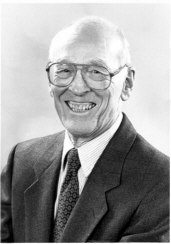
Paul D. Boyer
Professor Emeritus; PhD, Biochemistry, University of Wisconsin;
Postdoctoral, Stanford University; National Academy of Sciences;
Rose Award of the American Society of Biochemistry and Molecular Biology;
1997
Nobel
Prize in Chemistry
Research Description
Basic Features of the ATP Synthase Catalysis The membrane-bound ATP
synthase of animals, plants, and microorganisms is a highly conserved
enzyme
with unusual subunit stoichiometry and properties. In the binding change
mechanism for the synthase developed by our laboratory, translocation of
protons is regarded as driving conformational changes that promote release
of
a tightly bound ATP at one catalytic site and the tight binding of ADP and
Pi
at another catalytic site. An interesting speculation is that catalysis is
accompanied by a rotational movement of catalytic subunits relative to a
noncatalytic core.
Probes of Catalysis and Control We use a combination of chemical
derivatization, nucleotide binding and other catalytic site occupancy
measurements, conformational and structural probes, subunit isolation and
interchange evaluations, subunit cross-linking 18O-phosphate
exchange measurements, site-specific mutagenesis, and rapid mixing and
rate of
catalysis approaches. One example is the use of 2-azido ATP and ADP.
These
are good substrates that when photoactivated covalently modify nucleotide
binding sites. Another is the phosphate oxygen exchange methodology
that reveals reactions occurring while substrates are still bound and
whether
the catalysis occurs by one of more pathways.
Additional pictures of Paul Boyer and links to
Nobel
Prize articles
Paul Boyer wins UCLA Medal (April 10, 1998)
